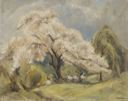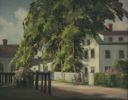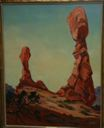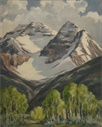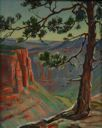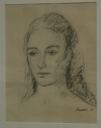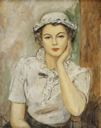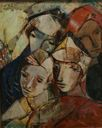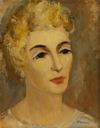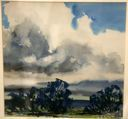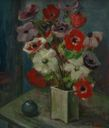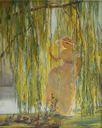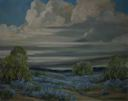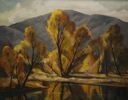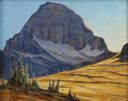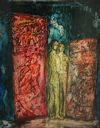Theodore Milton Wassmer does not have an image.
Theodore Milton Wassmer
(Salt Lake City, Utah, 1910 - 2006, Salt Lake City, Utah)
Theodore Milton Wassmer was an American painter with a passion for the visual and musical arts. He was born in Salt Lake City, Utah, on the 23rd of February, 1910, the eldest of eight children. As a youth, he enjoyed many sports ranging from baseball, basketball, swimming, and skiing to fishing. He also sought to express himself musically and on the stage. Formal training was beyond his means, but by watching others, he learned to play the piano. From childhood, he was fascinated by colors. He would sit for hours and contemplate the variations of white in cloud formations, the sonorous sunsets, the snow-covered peaks, and the nostalgic kaleidoscope of autumn. "I would sit on the edge of the lake at Liberty Park," he muses, "and observe the trees' reflections and wonder if there were some way to record it all in color." But it was not until his seventh-grade teacher, Mattie C. Sanford, put up a still life in a "once a week" art class that he knew it was possible to create a painting. At this time, Wassmer had never seen an oil painting, nor an artist at work. It was not until 1927, when he met the elderly French painter, Frank Zimbeaux, then living in Salt Lake City, that he was introduced to the visual arts. He impetuously told Zimbeaux that he too wanted to be an artist and asked to buy a picture by the painter. He took the masterpiece home and tried to copy Zimbeaux' technique. From then on, Wassmer knew that this was the avenue to express his feelings about color--with paint, brush, and canvas. The Great Depression hit Utah hard in 1931. The working members of Wassmer's family all lost their jobs, leaving him the sole support of ten on his $55-per-month salary. In 1933, he finally was able to buy some oil points and make his own canvas boards. Becoming a painter was now his sole interest. Wassmer noted that "I showed some of my work to Miss Corneck at the Pembroke Company where I purchased my art materials. She said she felt I had a lot of talent and suggested that I get in touch with Florence Ware, a recognized teacher of art in our city." It took Wassmer a year to gain the courage to call on Miss Ware. When he did, she liked his work and told him to paint 50 more landscapes and come back and see her in a year. He did just that after visiting the World's Fair in Chicago and viewing the masters on display. A friendship developed between the two that lasted many years. Wassmer helped Miss Ware on Works Project Administration projects as well as modeling for her. The war interrupted Wassmer's art career when he enlisted in the Army Air Force early in January of 1942. A freak accident in July 1944 paralyzed his painting arm. The experience was devastating. He was sent to a hospital in Brigham City, Utah, to see if use of his arm could be restored. In late October 1945, after nearly four years in the Army Air Force, he was discharged with about 10 percent use of his injured arm. In December of 1945, he married Judy Farnsworth Lund in New York City, whom he had known and courted since the 30s. Judy had been the Utah State Art director for the WPA for a number of years, before moving to Manhattan in 1938. She too, was a fine artist and a painter. Although she was the light of his life, it had been a long-distance relationship. They spent the following summer painting on Cape Cod. Wassmer studied for four years at the Art Student's League in both New York City and Woodstock. The innovations then taking place in New York were beginning to have an effect on the impressionable young artist. He began studying the Impressionists and Paul Cezanne, a Post-Impressionist. He also copied the old masters at the Metropolitan Museum of Art. In 1952, the Wassmers decided the quiet and clean air of country living would provide a more congenial atmosphere for their creative efforts. They purchased an old stone house in Bearsville, New York, two miles from the famous Woodstock Art Colony. To further their art education and refill their creative reservoirs, they made two trips to Europe, studying in the museums of Spain and Italy. Wassmer's prolific body of works attest to his artistic commitment. Over 2,000 of his paintings, watercolors, and drawings are in the hands of private collectors, museums, colleges, and schools in the United States and Europe. He has always had a happy outlook on life and yet has found art to be a lonely pursuit. He believes art is a dialogue with oneself, while working out personal conflicts. As all true artists must, Wassmer draws from his own reality--where the aura of mystery is created. In late 1985, the Wassmers sold their property in New York and returned to Salt Lake City, where they now reside and are active in the fine arts throughout the state. They have been particularly generous to the Springville Museum of Art, where their donations have established the Lund-Wassmer Collection. This collection was deeded to the museum to promote art education in the state. The Wassmers continue to donate both art and funds to support the museum's collection. During August 1995, Ted Wassmer had a retrospective exhibit of his work at the Springville Musem of Art. Wassmer died in Salt Lake City, Utah on November 26, 2006.
(Salt Lake City, Utah, 1910 - 2006, Salt Lake City, Utah)
Theodore Milton Wassmer was an American painter with a passion for the visual and musical arts. He was born in Salt Lake City, Utah, on the 23rd of February, 1910, the eldest of eight children. As a youth, he enjoyed many sports ranging from baseball, basketball, swimming, and skiing to fishing. He also sought to express himself musically and on the stage. Formal training was beyond his means, but by watching others, he learned to play the piano. From childhood, he was fascinated by colors. He would sit for hours and contemplate the variations of white in cloud formations, the sonorous sunsets, the snow-covered peaks, and the nostalgic kaleidoscope of autumn. "I would sit on the edge of the lake at Liberty Park," he muses, "and observe the trees' reflections and wonder if there were some way to record it all in color." But it was not until his seventh-grade teacher, Mattie C. Sanford, put up a still life in a "once a week" art class that he knew it was possible to create a painting. At this time, Wassmer had never seen an oil painting, nor an artist at work. It was not until 1927, when he met the elderly French painter, Frank Zimbeaux, then living in Salt Lake City, that he was introduced to the visual arts. He impetuously told Zimbeaux that he too wanted to be an artist and asked to buy a picture by the painter. He took the masterpiece home and tried to copy Zimbeaux' technique. From then on, Wassmer knew that this was the avenue to express his feelings about color--with paint, brush, and canvas. The Great Depression hit Utah hard in 1931. The working members of Wassmer's family all lost their jobs, leaving him the sole support of ten on his $55-per-month salary. In 1933, he finally was able to buy some oil points and make his own canvas boards. Becoming a painter was now his sole interest. Wassmer noted that "I showed some of my work to Miss Corneck at the Pembroke Company where I purchased my art materials. She said she felt I had a lot of talent and suggested that I get in touch with Florence Ware, a recognized teacher of art in our city." It took Wassmer a year to gain the courage to call on Miss Ware. When he did, she liked his work and told him to paint 50 more landscapes and come back and see her in a year. He did just that after visiting the World's Fair in Chicago and viewing the masters on display. A friendship developed between the two that lasted many years. Wassmer helped Miss Ware on Works Project Administration projects as well as modeling for her. The war interrupted Wassmer's art career when he enlisted in the Army Air Force early in January of 1942. A freak accident in July 1944 paralyzed his painting arm. The experience was devastating. He was sent to a hospital in Brigham City, Utah, to see if use of his arm could be restored. In late October 1945, after nearly four years in the Army Air Force, he was discharged with about 10 percent use of his injured arm. In December of 1945, he married Judy Farnsworth Lund in New York City, whom he had known and courted since the 30s. Judy had been the Utah State Art director for the WPA for a number of years, before moving to Manhattan in 1938. She too, was a fine artist and a painter. Although she was the light of his life, it had been a long-distance relationship. They spent the following summer painting on Cape Cod. Wassmer studied for four years at the Art Student's League in both New York City and Woodstock. The innovations then taking place in New York were beginning to have an effect on the impressionable young artist. He began studying the Impressionists and Paul Cezanne, a Post-Impressionist. He also copied the old masters at the Metropolitan Museum of Art. In 1952, the Wassmers decided the quiet and clean air of country living would provide a more congenial atmosphere for their creative efforts. They purchased an old stone house in Bearsville, New York, two miles from the famous Woodstock Art Colony. To further their art education and refill their creative reservoirs, they made two trips to Europe, studying in the museums of Spain and Italy. Wassmer's prolific body of works attest to his artistic commitment. Over 2,000 of his paintings, watercolors, and drawings are in the hands of private collectors, museums, colleges, and schools in the United States and Europe. He has always had a happy outlook on life and yet has found art to be a lonely pursuit. He believes art is a dialogue with oneself, while working out personal conflicts. As all true artists must, Wassmer draws from his own reality--where the aura of mystery is created. In late 1985, the Wassmers sold their property in New York and returned to Salt Lake City, where they now reside and are active in the fine arts throughout the state. They have been particularly generous to the Springville Museum of Art, where their donations have established the Lund-Wassmer Collection. This collection was deeded to the museum to promote art education in the state. The Wassmers continue to donate both art and funds to support the museum's collection. During August 1995, Ted Wassmer had a retrospective exhibit of his work at the Springville Musem of Art. Wassmer died in Salt Lake City, Utah on November 26, 2006.
Artist Objects
